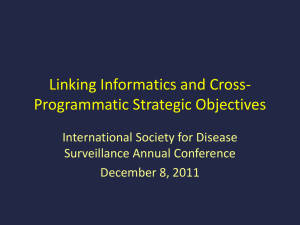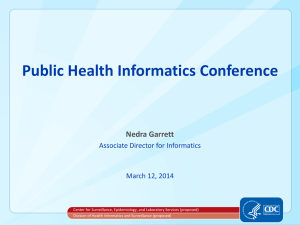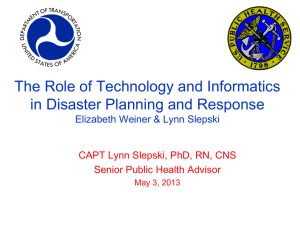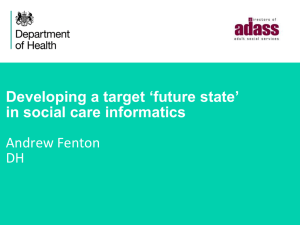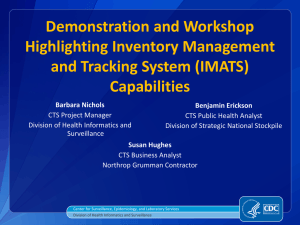St. Louis - Public Health Informatics Conference
advertisement
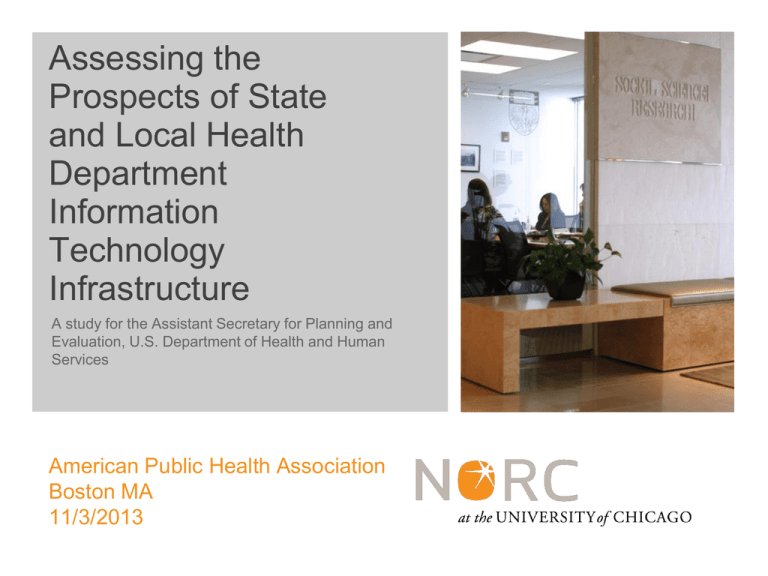
Assessing the Prospects of State and Local Health Department Information Technology Infrastructure A study for the Assistant Secretary for Planning and Evaluation, U.S. Department of Health and Human Services American Public Health Association Boston MA 11/3/2013 Project Overview • Purpose • Assess current status of IT in public health • Document recent opportunities and progress • Develop potential next steps for policy and program officials at all levels • Approach • Two technical expert panel (TEP) meetings • Environmental scan • Three in-depth case studies based on site visits to state and local agencies: Florida, Oregon, Michigan Sites selected both to highlight innovation and obtain a broad understanding of “day to day” system use • Team: Karen Swietek, Sara Levintow, Alana Knudson, Prashila Dullabh, Cheryl Austein Casnoff, Mike Millman (ASPE), Adil Moiduddin 2 Relevant Data Private Providers: PH Services: e.g., TB, STD, HIV, home visiting clinics, laboratory and case management, Women, Infant and Children (WIC) Health Records: e.g., newborn screening, vital statistics, early hearing, immunizations, cancer e.g., emergency departments, hospital infection specialists, commercial labs, primary care providers, behavioral health Environmental Health: e.g., licenses and inspection data maintained by local public health Models for Integration, Interoperability and Exchange to support needs assessment, care coordination, health care quality improvement, monitoring and surveillance. Surveillance: e.g., communicable diseases, STDs, syndromic surveillance, BRFSS Program Management: e.g., Ryan White, Title V, mental health / substance abuse programs Social Service Records: e.g., Schools, Housing Assistance, Nutrition Support, Heating Assistance Health Care Administrative Records: Medicaid Enrollment, Eligibility and Encounters; AllPayer Claims Red (bottom): data typically managed by state health departments Blue: data typically managed by local health departments Green: data typically managed by private providers Purple: data typically managed by other social welfare agencies 3 “Opportunity” 1 IT • MU enhances incentives for electronic reporting to public health (ELR, immunizations, cancer, syndromic surveillance), but no systematic way to upgrade state public health systems receiving data • PH agencies serve as care providers, but few qualify for MU • Limited billing to Medicaid and Medicare • Many public health nurses do not meet “eligible provider” criteria • Relatively few PH agencies use accredited EHRs • State Health Information Exchange and Beacon Programs • “public health hub” for public health reporting through a single portal • PH is at the center of efforts to reduce hospital admission for ambulatory care sensitive conditions (e.g., SE Minnesota) 4 “Opportunity” 2 Reform • ACA goals and public health functions overlap • Coordination (case management) and prevention • Use of “community pathway hubs” to improve connectivity to social services • Sharing data across public service agencies • Role of public health in QI and health promotion through engagement with providers • using EHR data to profile provider quality indicators • chronic disease registries • quality reporting to support Medicaid demonstrations 5 “Opportunity” 3 Science • A logical premise: right information to the right person at the right time Public health mission Public health activities Workflow and data flow Systems requirements • Commitment to this idea on multiple fronts • • • • RWJF projects, “Common Ground” Public Health Data Standards Consortium (PHDSC) Standards and Interoperability (S&I) Framework Integrating the Healthcare Enterprise • Key accomplishments to date • Specifications for reporting to cancer registries, early hearing detection and intervention, immunization reporting • Use of clinical document architecture (CDA) or HL7 2.5.1 messaging • Translating advances in PH informatics “on the ground” is not easy 6 …Funding Issues • Varies considerably due to varying state and local budgets • Plurality comes in the form of program funding from state and federal sources • Federal funds are typically administered by the state who work with local health departments as service providers • IOM and others note that public health is under-funded • Funding mechanisms constraint IT investments • Use of operational budgets rather than capital budgets • Lack of flexibility in use of categorical funds • Limited sustained funding focused on encouraging systems improvements linked to analysis of business processes, workflow and needs 7 Areas of Progress • Use of information systems among public health agencies has evolved in useful ways • Increased awareness of need for public health informatics • Increased use of some systems and electronic reporting (ELR, immunizations) • Comprehensive understanding of public health business rules is necessary • Necessary for overcoming silos • Necessary for creating a framework for wise strategic investment • New business rules for “evolving” functions such as chronic disease surveillance • Vision and framework for capturing data more realistic than a formal architecture • Vendor community and public health informatics leaders propose “modular” solutions using a common databases or meta-data models 8 Winds of Change • Population health becomes and increasing focus in health care policy (“third part of the three aim”) • Vision can come from multiple places • State public health agency • State Medicaid agency • Public health agencies may have skills / resources required to achieve health care objectives • Care coordination • Linking “high-cost” patients to important social services to improve QoL and lower cost • However, their traditional role within the safety net will change • Prevention and clinical safety net roles may change 9 Some Lessons • Organization matters • Level of consolidation across state and local agencies • Integration between Medicaid and public health • Varying issues between state and locals • Locals in search of a “public health EHR“ + efficient ways to report • Locals need case management and specialized clinical modules (e.g., HIV) • State focused on monitoring, surveillance and population data • Some public health agencies are better positioned • Planning should occur before grant opportunities arise • Requires advanced capacity to receive health IT incentive payments, not just data from providers • Basic systems documentation / education is the first step • Many public health agencies do not have a single list of all systems being used and their relationships 10 Workforce Imperative • Public health workforce with key gaps • Knowledge of informatics, continuous quality improvement • Knowledge of the best use of provider generated data (e.g., EHR data) • Capacity to coordinate with others to assure access to care • Leadership matters • Involvement / knowledge of national initiatives • Combined knowledge of public health workflows and informatics • Realistic approach balanced with vision for future investments 11 More Work Needed • Documenting business case and workflow for public health partnership with providers • Recent funded project from ASPE will do this for 3 chronic illnesses • Models for strategic planning and coordination between state and local stakeholders to plan investments as opportunities arise • Predictable funders that encourages innovation, flexibility and economies of scale • Expanded training for public health practitioners •“Real world” tests for informatics advances 12 Thank You! Michael Millman U.S. Department of Health and Human Services Michael.Millman@hhs.gov Adil Moiduddin NORC at the University of Chicago Moiduddin-adil@norc.org Full Report Available Online: http://aspe.hhs.gov/sp/reports/2013/PublicHealthInformatics/hitech_rpt.cfm Other ASPE Public Health Reports: http://aspe.hhs.gov/sp/reports/ 13
